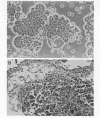Abstract
An immunotoxin composed of Pseudomonas toxin coupled to an antibody to the human transferrin receptor was evaluated for its effect on ovarian cancer. In the tumor model employed, 60 million human ovarian cancer cells were injected into the peritoneal cavity of an immunodeficient nude mouse. By day 5, cancer cells were implanted and growing in small clusters throughout the peritoneal cavity. On days 5-8, 0.3-2 micrograms of immunotoxin was injected into the peritoneal cavity. Control mice died with malignant ascites at 34-58 days after the implantation of tumor cells, whereas immunotoxin-treated mice lived to 100 days or longer. Irrelevant immunotoxins or antibody alone had no antitumor activity. These findings suggest that intraperitoneal injection of immunotoxins may have a role in the treatment of ovarian cancer.
Full text
PDF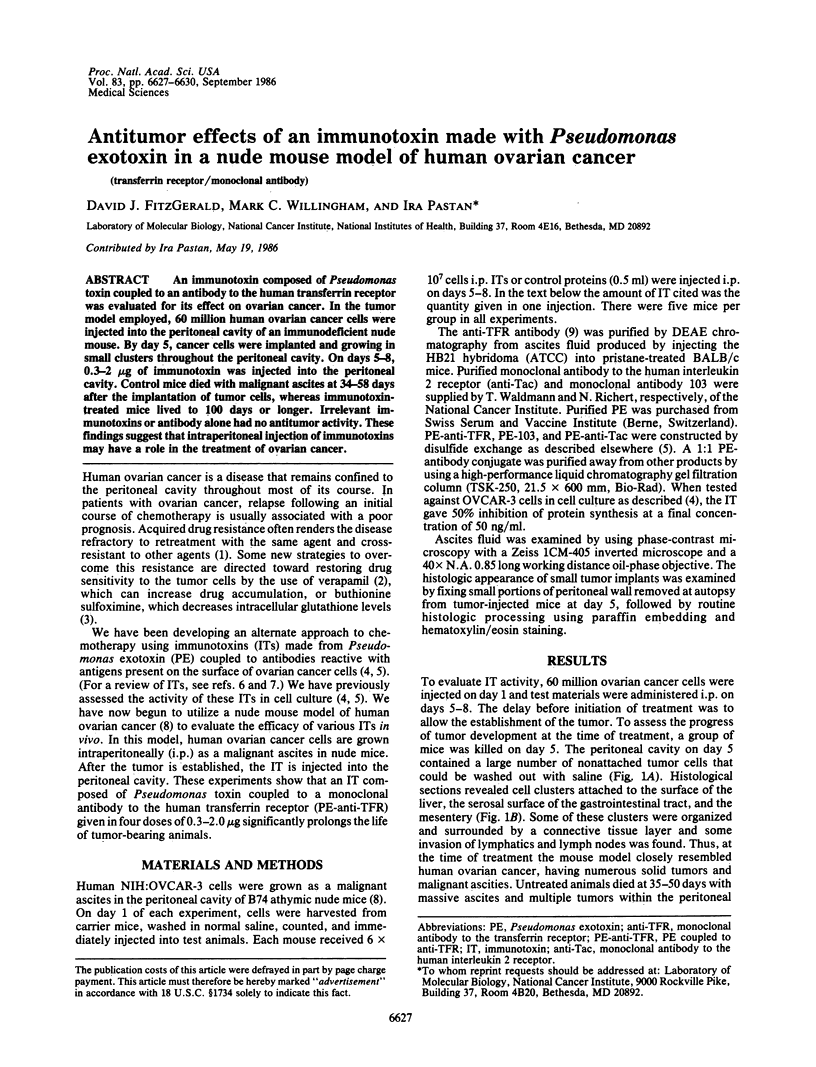
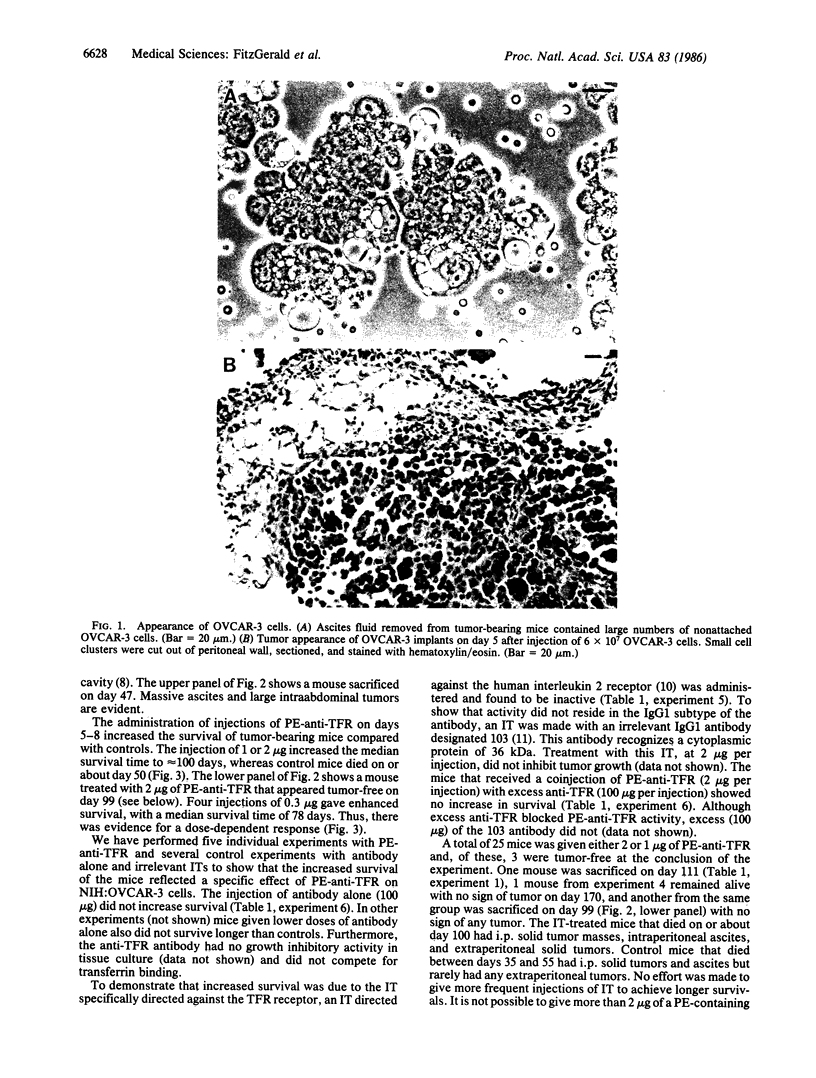
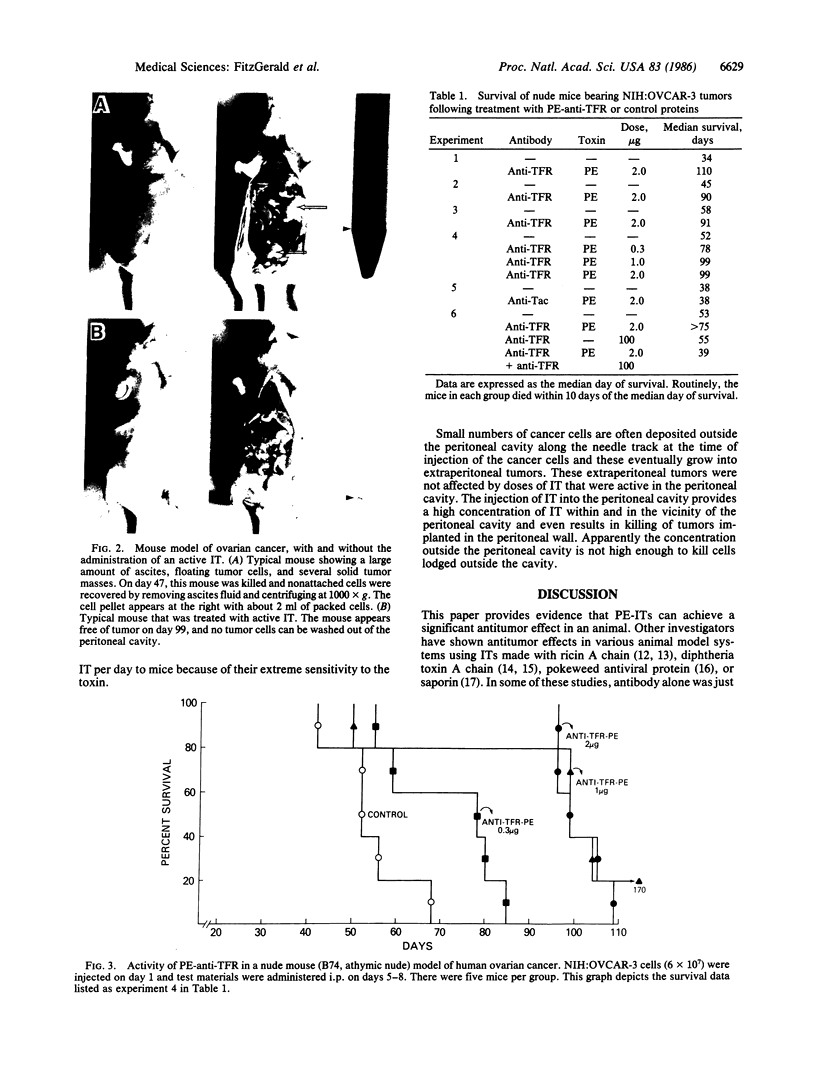
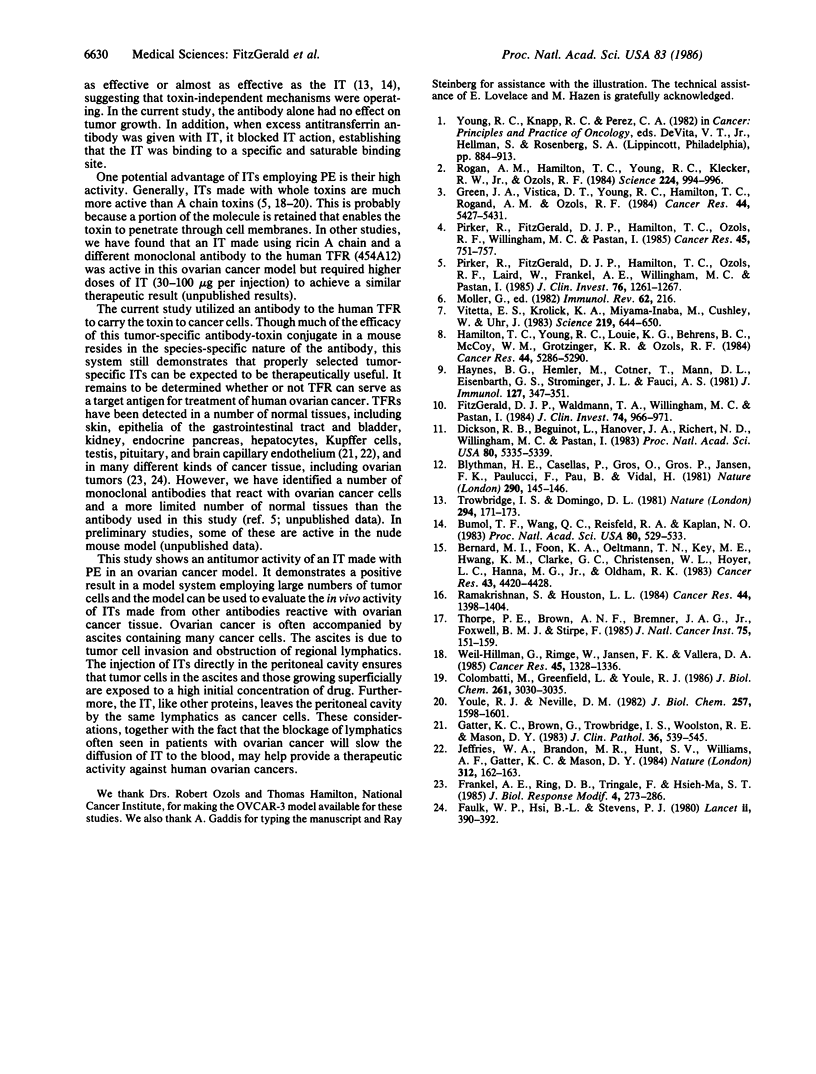
Images in this article
Selected References
These references are in PubMed. This may not be the complete list of references from this article.
- Bernhard M. I., Foon K. A., Oeltmann T. N., Key M. E., Hwang K. M., Clarke G. C., Christensen W. L., Hoyer L. C., Hanna M. G., Jr, Oldham R. K. Guinea pig line 10 hepatocarcinoma model: characterization of monoclonal antibody and in vivo effect of unconjugated antibody and antibody conjugated to diphtheria toxin A chain. Cancer Res. 1983 Sep;43(9):4420–4428. [PubMed] [Google Scholar]
- Blythman H. E., Casellas P., Gros O., Gros P., Jansen F. K., Paolucci F., Pau B., Vidal H. Immunotoxins: hybrid molecules of monoclonal antibodies and a toxin subunit specifically kill tumour cells. Nature. 1981 Mar 12;290(5802):145–146. doi: 10.1038/290145a0. [DOI] [PubMed] [Google Scholar]
- Bumol T. F., Wang Q. C., Reisfeld R. A., Kaplan N. O. Monoclonal antibody and an antibody-toxin conjugate to a cell surface proteoglycan of melanoma cells suppress in vivo tumor growth. Proc Natl Acad Sci U S A. 1983 Jan;80(2):529–533. doi: 10.1073/pnas.80.2.529. [DOI] [PMC free article] [PubMed] [Google Scholar]
- Colombatti M., Greenfield L., Youle R. J. Cloned fragment of diphtheria toxin linked to T cell-specific antibody identifies regions of B chain active in cell entry. J Biol Chem. 1986 Mar 5;261(7):3030–3035. [PubMed] [Google Scholar]
- Dickson R. B., Beguinot L., Hanover J. A., Richert N. D., Willingham M. C., Pastan I. Isolation and characterization of a highly enriched preparation of receptosomes (endosomes) from a human cell line. Proc Natl Acad Sci U S A. 1983 Sep;80(17):5335–5339. doi: 10.1073/pnas.80.17.5335. [DOI] [PMC free article] [PubMed] [Google Scholar]
- Faulk W. P., Hsi B. L., Stevens P. J. Transferrin and transferrin receptors in carcinoma of the breast. Lancet. 1980 Aug 23;2(8191):390–392. doi: 10.1016/s0140-6736(80)90440-7. [DOI] [PubMed] [Google Scholar]
- FitzGerald D. J., Waldmann T. A., Willingham M. C., Pastan I. Pseudomonas exotoxin-anti-TAC. Cell-specific immunotoxin active against cells expressing the human T cell growth factor receptor. J Clin Invest. 1984 Sep;74(3):966–971. doi: 10.1172/JCI111516. [DOI] [PMC free article] [PubMed] [Google Scholar]
- Frankel A. E., Ring D. B., Tringale F., Hsieh-Ma S. T. Tissue distribution of breast cancer-associated antigens defined by monoclonal antibodies. J Biol Response Mod. 1985 Jun;4(3):273–286. [PubMed] [Google Scholar]
- Gatter K. C., Brown G., Trowbridge I. S., Woolston R. E., Mason D. Y. Transferrin receptors in human tissues: their distribution and possible clinical relevance. J Clin Pathol. 1983 May;36(5):539–545. doi: 10.1136/jcp.36.5.539. [DOI] [PMC free article] [PubMed] [Google Scholar]
- Green J. A., Vistica D. T., Young R. C., Hamilton T. C., Rogan A. M., Ozols R. F. Potentiation of melphalan cytotoxicity in human ovarian cancer cell lines by glutathione depletion. Cancer Res. 1984 Nov;44(11):5427–5431. [PubMed] [Google Scholar]
- Hamilton T. C., Young R. C., Louie K. G., Behrens B. C., McKoy W. M., Grotzinger K. R., Ozols R. F. Characterization of a xenograft model of human ovarian carcinoma which produces ascites and intraabdominal carcinomatosis in mice. Cancer Res. 1984 Nov;44(11):5286–5290. [PubMed] [Google Scholar]
- Haynes B. F., Hemler M., Cotner T., Mann D. L., Eisenbarth G. S., Strominger J. L., Fauci A. S. Characterization of a monoclonal antibody (5E9) that defines a human cell surface antigen of cell activation. J Immunol. 1981 Jul;127(1):347–351. [PubMed] [Google Scholar]
- Jefferies W. A., Brandon M. R., Hunt S. V., Williams A. F., Gatter K. C., Mason D. Y. Transferrin receptor on endothelium of brain capillaries. Nature. 1984 Nov 8;312(5990):162–163. doi: 10.1038/312162a0. [DOI] [PubMed] [Google Scholar]
- Pirker R., FitzGerald D. J., Hamilton T. C., Ozols R. F., Laird W., Frankel A. E., Willingham M. C., Pastan I. Characterization of immunotoxins active against ovarian cancer cell lines. J Clin Invest. 1985 Sep;76(3):1261–1267. doi: 10.1172/JCI112082. [DOI] [PMC free article] [PubMed] [Google Scholar]
- Pirker R., FitzGerald D. J., Hamilton T. C., Ozols R. F., Willingham M. C., Pastan I. Anti-transferrin receptor antibody linked to Pseudomonas exotoxin as a model immunotoxin in human ovarian carcinoma cell lines. Cancer Res. 1985 Feb;45(2):751–757. [PubMed] [Google Scholar]
- Ramakrishnan S., Houston L. L. Prevention of growth of leukemia cells in mice by monoclonal antibodies directed against Thy 1.1 antigen disulfide linked to two ribosomal inhibitors:pokeweed antiviral protein or ricin A chain. Cancer Res. 1984 Apr;44(4):1398–1404. [PubMed] [Google Scholar]
- Rogan A. M., Hamilton T. C., Young R. C., Klecker R. W., Jr, Ozols R. F. Reversal of adriamycin resistance by verapamil in human ovarian cancer. Science. 1984 Jun 1;224(4652):994–996. doi: 10.1126/science.6372095. [DOI] [PubMed] [Google Scholar]
- Thorpe P. E., Brown A. N., Bremner J. A., Jr, Foxwell B. M., Stirpe F. An immunotoxin composed of monoclonal anti-Thy 1.1 antibody and a ribosome-inactivating protein from Saponaria officinalis: potent antitumor effects in vitro and in vivo. J Natl Cancer Inst. 1985 Jul;75(1):151–159. [PubMed] [Google Scholar]
- Trowbridge I. S., Domingo D. L. Anti-transferrin receptor monoclonal antibody and toxin-antibody conjugates affect growth of human tumour cells. Nature. 1981 Nov 12;294(5837):171–173. doi: 10.1038/294171a0. [DOI] [PubMed] [Google Scholar]
- Vitetta E. S., Krolick K. A., Miyama-Inaba M., Cushley W., Uhr J. W. Immunotoxins: a new approach to cancer therapy. Science. 1983 Feb 11;219(4585):644–650. doi: 10.1126/science.6218613. [DOI] [PubMed] [Google Scholar]
- Weil-Hillman G., Runge W., Jansen F. K., Vallera D. A. Cytotoxic effect of anti-Mr 67,000 protein immunotoxins on human tumors in a nude mouse model. Cancer Res. 1985 Mar;45(3):1328–1336. [PubMed] [Google Scholar]
- Youle R. J., Neville D. M., Jr Kinetics of protein synthesis inactivation by ricin-anti-Thy 1.1 monoclonal antibody hybrids. Role of the ricin B subunit demonstrated by reconstitution. J Biol Chem. 1982 Feb 25;257(4):1598–1601. [PubMed] [Google Scholar]



